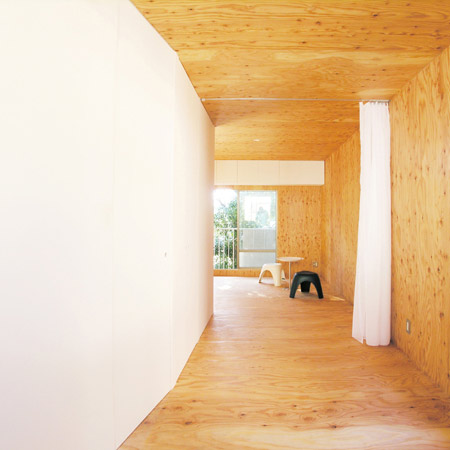Masahiro Kinoshita of Kino architects has completed the interior of an apartment in Tokyo, Japan.
The residence is divided into two distinct areas - a white-painted portion comprising a kitchen, toilet, bathroom and closet with fixed layouts, and a wood-paneled space to be arranged according to the occupant's needs.
Here's some more information from Masahiro Kinoshita:
--
Corner House
Decomposing Rigidity
The purpose of this project was to remodel an apartment suite that is attached to a landowner’s house. Before any remodelling took place, the apartment’s layout was a common, Japanese –style “2DK”, which consists of two private bedrooms, a dining room that is connected to the kitchen, a bathroom, and a rest room. This is the standard layout for a large number of Japanese apartments in Tokyo, but is far too outdated and rigid for modern urbanites.
With this concept in mind, KINO architects proposed two spaces to break down the rigidity of the 2DK apartment – “White Space” and “Wood Space”.
White Space
The “White Space” consists of a wet area (kitchen, toilet, bathroom, and washing basin) and a closet. The volume was based on three factors – the wet area facilities, the overall storage space, and the user’s body size. Unless you have lived in Tokyo before, it is difficult to imagine the spatial limitations we go through everyday. It is necessary to design both highly functional and densely compact apartments – hence, the high number of “rigid” 2DKs. By combining all the daily “necessities” into one space, we were able to break out of this old-fashioned layout to create an area that suits the modern generation’s needs.
Wood Space
The main theme of the “Wood Space” is flexibility, which is why we chose to use an L-shape. While it is only a single room, the L-shape allows the area to be divided into two or three distinctive sections, depending on how the user sees fit. Therefore, the apartment can become acclimatized to several activities at any one time – it becomes a more natural environment because the areas created by the user will not impede upon one another.
It is uncommon for living spaces to contain the two key characteristics of this project, Functionality and Flexibility. It is through the combination of both the “White” and “Wood” Spaces that make it possible to have these two traits co-exist, augmenting the overall desired effects within a small space.
Remodelling as a Tool for Sustainability
Ise-jingu, one of the most famous wooden shrines in Japan, is torn down and rebuilt once every twenty years. This does not seem like a sustainable practice, considering stonemasonry or poured-concrete last much longer. Wood does not last as long as the aforementioned materials, but can be just as sustainable because it has the flexibility to be constantly reformed or remodelled to whatever design we desire. This concept was applied to the “Wood Space”, making future plans for remodelling the landowner’s attached house quite flexible. Once the entire building is remodelled under this theme, it will “melt” away any rigidity of the previous floor plan, as the owner can adjust the balance between spaces as he sees fit.
architect: Masahiro Kinoshita / KINO architects
principal use: apartment / remodelling
structure: steel
total floor area: 42.80sqm
ceiling height: 2,370mm
photographs: Masahiro Kinoshita
More about Masahiro Kinoshita on Dezeen:
.

